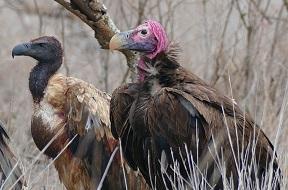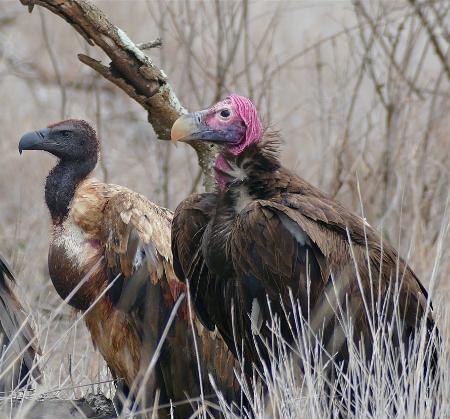Personal investigador de la Universidad de Oviedo alerta de que la persecución ilegal de elefantes, rinocerontes o jirafas en África puede fomentar el comercio de partes de estos carroñeros, un gremio en grave riesgo de extinción
El furtivismo asociado al comercio ilegal de colmillos de elefante, cuernos de rinoceronte o diferentes partes de jirafas, como pieles y huesos, no solamente amenaza la conservación de estas especies emblemáticas, sino que también tiene un impacto sobre otra fauna africana, como el caso de los buitres, tal y como señala un estudio de la Universidad de Oviedo publicado en la revista Biological Conservation. Cada vez con mayor frecuencia, los furtivos que persiguen a la megafauna africana envenenan las carroñas para evitar que los buitres, especializados en localizar rápidamente animales muertos, delaten la ubicación de estas actividades ilegales al personal encargado de combatirlas. Esta práctica, capaz de acabar con cientos de buitres en una sola carroña, está contribuyendo así al alarmante declive de las ocho especies de estas aves carroñeras presentes en África, cuyas poblaciones han disminuido un 62 % de media en las tres últimas décadas. Por ejemplo, recientemente se ha producido el envenenamiento de 537 buitres en tres carroñas de elefantes muertos a manos de los furtivos en Botsuana.
José Vicente López-Bao y Patricia Mateo-Tomás, autores de esta investigación, y colaboradores del Plan de Acción Español contra el tráfico ilegal y el furtivismo internacional de fauna y flora silvestres (Plan TIFIES), advierten de que el envenenamiento masivo de buitres en carroñas de otros animales víctimas de los furtivos puede además estimular el comercio ilegal de partes de buitres africanos para su uso en la medicina tradicional o muthi, considerada la segunda amenaza más importante para este gremio en África, después del envenenamiento. Se crea así una peligrosa sinergia que puede aumentar el interés por perseguir a los buitres para obtener partes de estas aves a través del envenenamiento de las carroñas de megafauna; especies que son a su vez víctimas del tráfico ilegal de fauna y flora, la cuarta actividad ilícita más grande del mundo.
El artículo destaca que, frente a los 26 buitres envenenados de media en tres eventos destinados a la captura directa de estas aves para abastecer el mercado tradicional, en una sola carroña de elefante abatido ilegalmente por los furtivos por sus colmillos, y posteriormente envenenada, se contabilizaron 65 buitres (de un total de 191 envenenados), a los que les faltaba el pico, un claro signo de aprovechamiento para la medicina tradicional.
El estudio pide mayor implicación internacional
El estudio enfatiza que son muy escasos los registros de la presencia de buitres mutilados muertos en carroñas de megafauna envenenadas por los furtivos. Por ello, reclaman mayor implicación de las autoridades encargadas de luchar contra el furtivismo, para realizar un seguimiento sistemático que permita estimar la magnitud real de esta perversa sinergia que se crea entre el furtivismo de megafauna y el comercio de partes de buitres. López-Bao y Mateo-Tomás sugieren tomar como punto de partida de dicho seguimiento algunos programas ya existentes, como el Programa de Seguimiento de Mortalidad Ilegal de Elefantes (MIKE) de la Convención sobre el Comercio Internacional de Especies Amenazadas de Fauna y Flora Silvestres (CITES), que recaban información sobre el furtivismo de elefantes mediante la localización de sus carroñas en multitud de zonas distribuidas por toda el área de distribución de las tres especies de elefantes presentes en la actualidad. Asimismo, remarcan la necesidad de ampliar estas medidas a otras especies amenazadas por la persecución ilegal, como los rinocerontes y las jirafas.
Datos del artículo
Mateo-Tomás P., López-Bao J.V. 2020. Poisoning poached megafauna can boost trade in African vultures. Biological Conservation 241: 108389.




